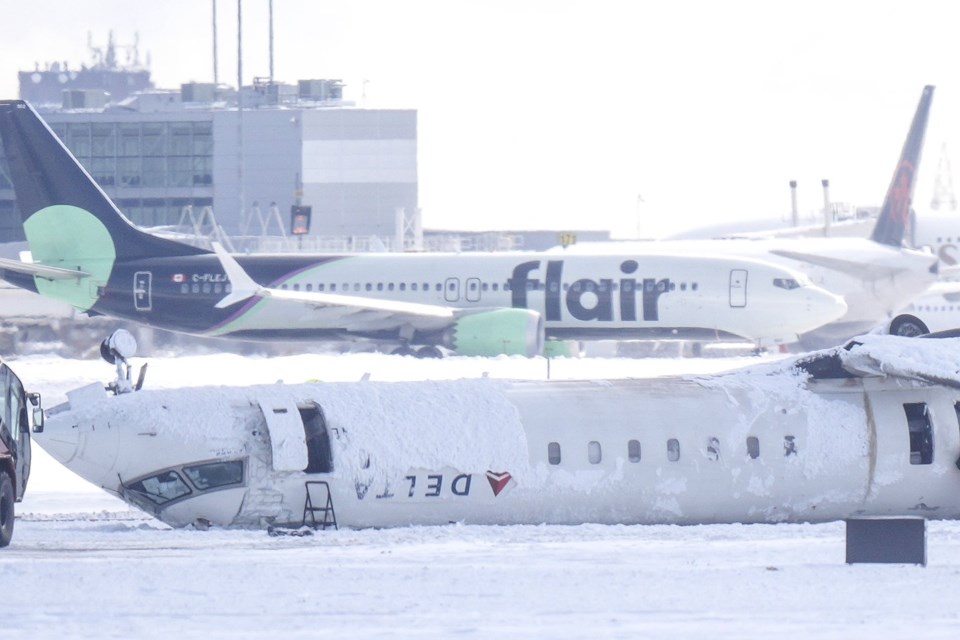A veteran aviator and flight instructor of commercial passenger jets says the "variable" gusty winds in Toronto as well as possible mechanical issues with the landing gear may have contributed to the Delta Air Lines crash at Pearson Airport Monday.
Kit Darby, a U.S.-based consultant with more than 20,000 hours of flight experience, says a review of videos as well as airport data on weather conditions showed a combination of factors that may have caused the plane's right wing tip to hit the ground, setting off the flip to its roof as it slid on the runway.
The crash of Delta flight 4819 from Minneapolis to Toronto at Canada's busiest airport left 21 people injured.
Darby says that planes typically "flare" slightly right before touching down, tipping the nose up to slow its rate of descent before touching the runway.
He says while videos taken of the crash make it "hard to judge how hard" the landing was, the typical flare and the accompanying slowing of descent speed "doesn't appear to happen."
Darby also says wind conditions at the airport were said to be gusty at the time, meaning that occasional bursts of strong winds could have created a "variable condition" at the actual moments right before touchdown.
"So, you could have it right one minute, but it wouldn't be right the next because of the gust or the changing conditions," he says. "The max wind (at the time) was near the aircraft limits had it been directly from the side, but it wasn't directly from the side — it was about 45 degrees from the front.
"So, it was controllable, but we don't know what the actual conditions were at the moment of touchdown," Darby adds. "There could have been a worse gust … if a similar strong gust hit right as they touch down, the airplane might have been uncontrollable."
On Tuesday, Toronto Pearson Airport CEO Deborah Flint said authorities would not speculate about the crash's possible cause as an active investigation is underway.
Videos of the crash on social media show the plane appearing to land hard on the runway then lean slightly to the right before the wing scraped the ground, creating a fireball as the aircraft rolled over and slid to a stop.
Renowned aviation safety analyst Gregory Feith posted images of the video on his Facebook page, describing the same lack of deceleration on descent noted by Darby.
"The new video clearly shows the (jet) landed in a slight right wing low, flat attitude at a descent rate that was not arrested by a landing flare," Feith says in his post.
"The right wing immediately disintegrated and the airplane rolled over to the right while sliding sideways," the post says. "The left wing remained attached, came over the top and struck the ground — which appears to have prevented the fuselage from continuing to roll."
Darby says that beyond the flight data and cockpit voice recorders as well as interviews with pilots, the landing mechanism would be among the first places investigators would look.
That's because, even without the flare reducing the speed of descent, the landing gear is designed to withstand that type of impact.
"I mean, you would be very uncomfortable (as a passenger) and the airplane would be fine, as long as you hit on those main gear first," he says. "And it does appear to be a main gear landing. The gear is designed to take that kind of abuse."
But it's what happened after that, he says, that set off the crash.
"Either something broke — landing gear, tire blew … or they banked the airplane too much and the wing tip hit the ground. Or a combination of those could have happened."
Flint said investigators from the Transportation Safety Board of Canada, as well as teams from the U.S. Federal Aviation Administration, Mitsubishi Aircraft Corporation and Delta are now at the scene and conducting the investigation.
This report by The Canadian Press was first published Feb. 18, 2025.
Chuck Chiang, The Canadian Press



